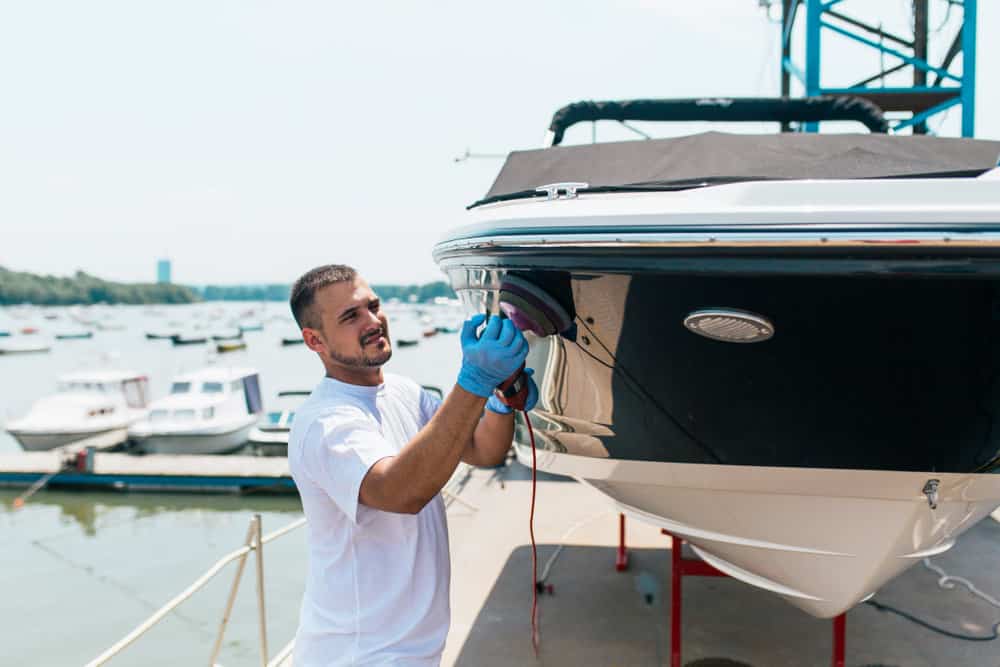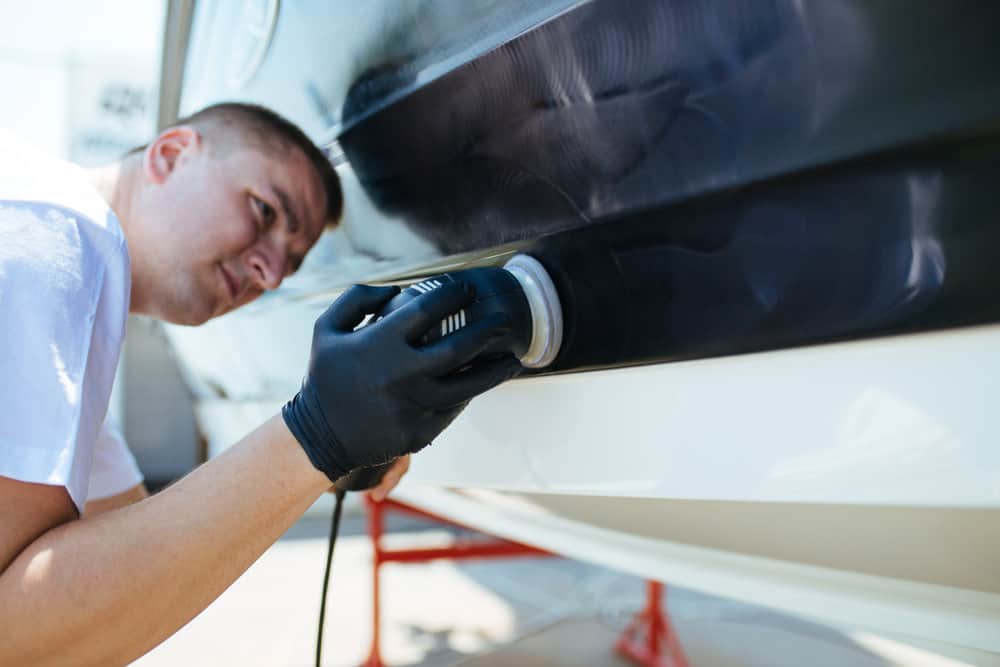Boating is a wonderful hobby that can involve the whole family. The cries of laughter from tubing or skiing during a day at the lake will create great memories for the future. The downside of owning a boat is that it requires constant maintenance to look and operate in top shape.
Yellow stains are the bane of owners of older boats. Follow the steps in this article to remove the yellow stains and restore the hull to its former glory.
How To Remove Yellow Stains From A Fiberglass Boat
Every boat owner who owns a fiberglass boat older than 4 – 5 years complains about the difficulty of removing the yellow stains that blight their vessel. At the same time, they also discuss the best way to renew the appearance of their boat, which has dulled with age.
So How Do You Remove The Stains?
Firstly, the good news; is this is a fixable problem, and the solution will remove the yellow stains and leave your boat Gelcoat in a new condition, with the luster restored.
Despite what some salesmen would have you believe, the solution isn’t found by simply applying a magical product and watching yellow stains drip off. The restoration requires some elbow grease and sweat equity on your behalf, but the results will be very satisfactory.
Step 1. Mix The Detergent
Use a mixture of concentrated dishwashing liquid and water and a separate standard bathroom cleaner bottle containing Teflon.
Pro Tip: Add one ounce of ammonia into the bucket.
Once you have the solution mixed, follow the following steps.
Step 2. Remove The Yellow Stains Park In Shaded Area
Park the trailer in a shady area, which remains out of the sun throughout the day.
Step 3. Wash The Boat

Gently wash the gel-coat surface with the mixed washing solution. You can clean the whole boat at this stage; however, when you start working on the restoration, it is recommended that you only work on a smaller section at a time.
This process removes the grease and oily deposits collected on the surface. It will also remove any wax applied in the past.
If you see stubborn yellow stains, apply liberal quantities of the Teflon bathroom cleaner and vigorously rub these with a microfibre cloth.
Step 4. Remove The Yellow Stains
While the boat is still wet from the cleaning application described in step 3, use a piece of 1200 grit wet/dry sandpaper, wet it thoroughly, and gently sand the area with a straight backward, forward motion. The essential keys to this step are.
- Don’t apply too much force.
- Don’t sand for too long.
- Use a straight backward and forward sanding motion.
- Continually rewet the sandpaper. If the paper gets too dry, it scratches the gel coat.
Don’t panic if the boat’s color starts appearing on the sandpaper; this is just the thin, damaged surface layer of the gel coat being removed.
Have patience and keep sanding in regular, evenly distanced sanding strokes.
When the surface begins to turn a light grey/white color, the top layer has been removed, and you are now at the clear gel-coat layer.
Use a clean, soft rag to clean the sanding residue off the gel coat surface and brush the palm of your hand over the area you have worked. If you still feel a grittiness, the surface contaminates have not been completely removed.
Step 5. Sand The Gelcoat Even Smoother
When satisfied that the surface is smooth enough, change to a 2000 grit wet/dry sandpaper and repeat the process.
The primary purpose of this step is to remove the minor scratches caused by the 1200 grit paper.
It is difficult to see when the surface is smooth enough, but you will be able to feel when it is very smooth, and your hand will be able to glide over the surface with no rough spots.
Step 6. Buff It Out

The next step is the buffing stage. Any gel coat cutting compound, such as this 3M product, will work.
Spray the product in liberal quantities onto the area you have sanded. One dry, use a rotary buffer with a white wool pad.
Using the lowest speed setting, start applying the buffing pad to the cutting compound by slowly working it in. As it progresses, you can steadily increase the speed. When the mixture has wholly disappeared, proceed to step 7.
Step 7. Polish The Boat And Remove Swirl Marks
Apply 3m “Perfect-It” No 2 to the surface you have been working on.
Using a waffle pad on the rotary buffer, set to the slowest speed to take out the swirl marks which will have been left in by the buffing wool pad from step 4.
Step 8. Wax The Restored Area

Apply Meguiar’s Cleaner Wax, or a similar product with a UV inhibitor in it, to the area being restored.
Hot tip, you can use liquid waxes; however, they are not as economical because the product drips and is more easily absorbed by the waxing cloths.
Using a small circular motion apply the wax to the area you are working on. Let the product dry until it reaches a hazy consistency, and then wipe it off with a clean microfiber cloth.
The Reason Why Yellow Stains Appear On Fiberglass Boats
There are several reasons why yellow stains occur on fiberglass boats, the main ones being.
Pollution And Other Debris
Our boats are often subjected to the most horrendous conditions, often without us knowing what is happening.
While the authorities try to regulate the E.coli concentrations, most dams and coastal waters are filled with unacceptable pollutants, including diesel, organic matter like algae, and non-hazardous bacteria washing against the hull.
The high mineral content in certain areas can also cause yellow stains.
Humans Are Not The Only Ones Who Get Wrinkles
As a boat’s gel coat ages, tiny cracks start to appear. The pollutants can penetrate these cracks, and the result is often a growing web of unsightly cracks.
White is most commonly used on fiberglass boat hulls, and the primary reason it is chosen is that it doesn’t absorb heat. It also makes these scratches less visible, which is excellent from an appearance perspective but does mean that the web has spread extensively by the time the cracks are noticed.
The Sun Is Not Kind To Gel Coat
As far as Gelcoat is concerned, the sun is a brutal enemy.
Unless the boat is always kept in a garage, the fading gel coat will become evident over time. White Gelcoat loses its luster; overextended exposure to the sun fades the hull to a cream or yellowish color.
A Thought At The End Of The Process
It is important not to sand, buff, or polish too far.
It is easy to go back and redo areas that you feel haven’t been worked enough, but if you go too far and penetrate through the gel coat to the fiberglass below, it will require a significant repair to correct the problem.
How Do You Stop Yellow Stains From Appearing?
There is no magical formula to stop yellow stains from appearing other than to thoroughly wash your boat every time you pull it out of the water and store it in an enclosed area that is protected from the sun.
Conclusion
Yellow stains which start to appear on your pride and joy are very frustrating. Unfortunately, they generally occur because you are using your boat for the purpose you purchased it. Pollution is a big problem for which there is no long-term solution.
Periodically renewing your boat’s appearance will add to the satisfaction of owning it and enhance its value.
Project “Keep That Boat Shiny” Boating
Check out our article on: How to Remove Boat Decals (3 Methods)

